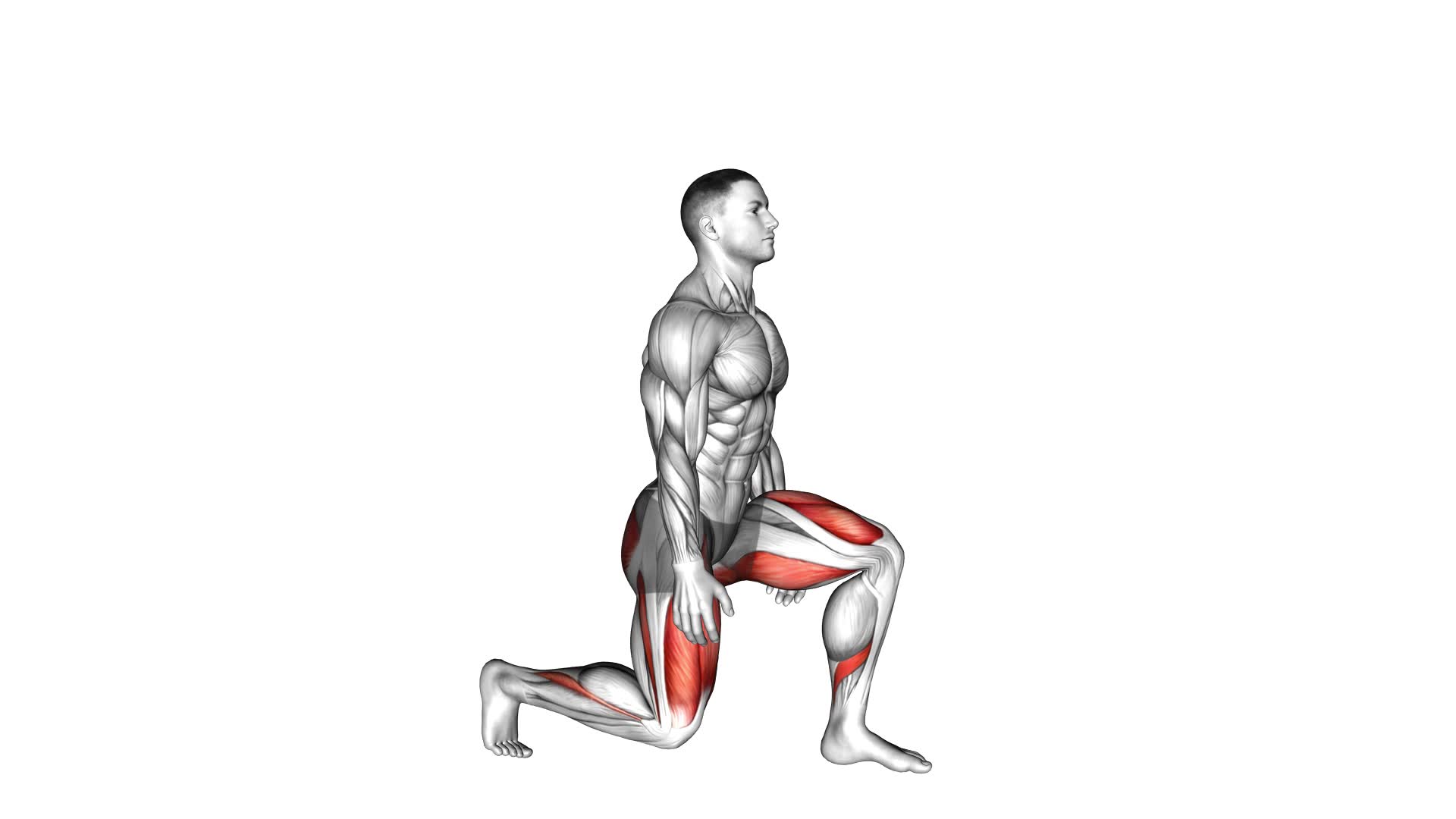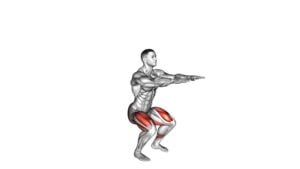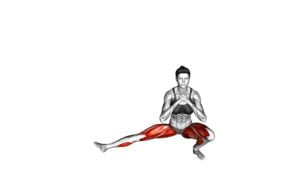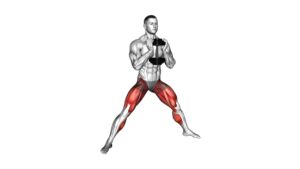Split Squats – Video Exercise Guide & Tips

Are you looking to level up your lower body workout? Look no further than split squats! This exercise targets your quads, glutes, and hamstrings all at once, giving you a killer workout.
Watch This Exercise Video
In this article, we'll provide you with a video exercise guide and share helpful tips to ensure you nail the proper form. Whether you're a beginner or a seasoned pro, there's something for everyone.
Get ready to feel the burn and get those legs stronger than ever!
Key Takeaways
- Split squats target multiple muscle groups simultaneously, including quads, glutes, and hamstrings.
- They improve balance, core strength, and muscle activation.
- Split squats can help correct imbalances and weaknesses in the lower body.
- By incorporating progressive overload techniques and variations, split squats can be adjusted to increase intensity and challenge muscles over time.
Benefits of Split Squats
You should regularly incorporate split squats into your workout routine because they offer numerous benefits. Split squats are a fantastic exercise for improving balance and muscle activation. When you perform split squats, you engage multiple muscle groups, including your quadriceps, glutes, hamstrings, and calves. This activation leads to increased strength and muscle development in these areas.
One of the key benefits of split squats is their ability to improve balance. By placing one foot forward and the other foot back, you challenge your stability and coordination. This exercise requires you to maintain proper form and control throughout the movement, which helps to strengthen your core and stabilizer muscles. Over time, this enhanced balance will translate into improved performance in other exercises and everyday activities.
Additionally, split squats are an excellent way to activate your muscles. By performing this exercise unilaterally, you ensure that each leg is working independently, which can help to correct any imbalances or weaknesses. This muscle activation can lead to improved overall strength and power in your lower body.
Incorporating split squats into your workout routine is a smart choice if you're looking to improve your balance and activate your muscles effectively. So, start adding this exercise to your workouts and experience the benefits for yourself.
Proper Form for Split Squats
To perform split squats with proper form, ensure that your front foot is positioned far enough forward and your back foot is positioned far enough back. This is important because it helps you maintain stability and balance throughout the exercise.
When setting up for a split squat, make sure your front foot is far enough forward that your knee remains directly over your ankle when you lower into the squat. Your back foot should be positioned far enough back that your knee hovers just above the ground when you lower down.
Proper form is crucial for maximizing the benefits of split squats and minimizing the risk of injury. By maintaining the correct foot positioning, you can engage the muscles in your lower body more effectively. This exercise primarily targets the quadriceps, hamstrings, and glutes.
If you're looking to modify the split squat to suit your fitness level or vary your routine, there are a few options. You can perform the exercise with dumbbells or a barbell to add resistance and increase the intensity. Alternatively, you can do split squats on an unstable surface, like a balance board or a BOSU ball, to challenge your core and improve stability.
Variations of Split Squats
Now that you have mastered the proper form for split squats, it's time to explore the exciting world of variations. Adding variations to your split squat routine can provide a range of benefits, such as targeting different muscle groups and increasing overall strength and stability.
In addition, I'll provide you with valuable tips to ensure proper form and technique for each variation, as well as recommendations for equipment that can enhance your split squat workouts.
Get ready to take your split squats to the next level and maximize your gains!
Benefits of Variations
Exploring different variations of split squats can provide a range of benefits for your lower body strength and stability. Here are three key advantages of incorporating variations into your split squat routine:
- Increased muscle activation: By performing split squats with different variations, such as front foot elevated or rear foot elevated, you can target different muscle groups within your lower body. This helps to activate and strengthen muscles like the glutes, hamstrings, quadriceps, and calves more effectively.
- Improved balance and stability: Split squats require you to maintain balance and stability throughout the movement, especially when performing variations like Bulgarian split squats or walking lunges. This not only strengthens your leg muscles but also enhances your overall balance and stability, which can benefit your performance in other exercises and daily activities.
- Reduced risk of injury: By incorporating variations of split squats into your routine, you can address muscle imbalances and strengthen the stabilizer muscles in your lower body. This can help improve your overall body mechanics, reduce the risk of injury, and enhance your athletic performance.
Form and Technique Tips
To perform variations of split squats with proper form and technique, focus on maintaining stability and balance throughout the movement.
Split squat modifications can help target different muscles and add variety to your workout routine. One modification is the Bulgarian split squat, where your rear foot is elevated on a bench or step. This variation increases the demand on your front leg and activates your glutes and quads even more.
Another modification is the lateral split squat, where you step out to the side instead of the front. This targets your inner and outer thighs, as well as your glutes.
Remember to engage your core, keep your chest upright, and lower your hips until your front thigh is parallel to the ground.
Equipment for Split Squats
You can perform variations of split squats with different equipment options. Here are three items that are highly recommended for split squat modifications:
- Dumbbells: Adding dumbbells to your split squats will increase the resistance and challenge your muscles even more. Hold a dumbbell in each hand while performing the exercise to target your lower body and build strength.
- Barbell: Using a barbell for split squats allows you to lift heavier weights and engage multiple muscle groups at once. This equipment option is perfect for those looking to increase overall strength and muscle mass.
- Resistance Bands: Incorporating resistance bands into your split squats can provide extra tension and help improve stability and balance. Loop the bands around your ankles or hold them in your hands to add an extra challenge to the exercise.
Common Mistakes to Avoid
Avoiding common mistakes is crucial when performing split squats. By being aware of these mistakes, you can't only prevent injury but also maximize the effectiveness of this exercise.
One common mistake to avoid is allowing your knee to extend past your toes during the lunge. This puts excessive stress on the knee joint and increases the risk of injury. To prevent this, focus on keeping your front knee directly above your ankle throughout the movement.
Another mistake is leaning too far forward or backward, which can compromise your form and stability. Instead, maintain an upright posture with your chest lifted and shoulders back.
It's also important to avoid using too much momentum or relying on your back leg for support. This takes away the emphasis from the targeted muscles and reduces the effectiveness of the exercise.
Lastly, make sure to engage your core and maintain proper breathing throughout the movement.
Tips for Increasing Intensity
To increase the intensity of your split squats, try incorporating progressive overload techniques. This means gradually increasing the weight or resistance over time to challenge your muscles even more.
Another effective way to amp up the intensity is by incorporating supersets into your split squat routine. This involves performing another exercise immediately after your split squats, targeting different muscle groups and keeping your heart rate up for an added challenge.
Progressive Overload Techniques
To increase the intensity of your split squats, incorporate progressive overload techniques. Here are three effective progression methods that you can try:
- Increase the weight: Gradually add more weight to your split squats by using dumbbells or a barbell. This will challenge your muscles and help you build strength over time.
- Incorporate resistance bands: Attach resistance bands to your ankles or hold them in your hands while performing split squats. The added resistance will engage your muscles even more, making the exercise more challenging and effective.
- Adjust the tempo: Slow down the lowering phase of the split squat and pause at the bottom for a few seconds before coming back up. This will increase the time under tension and make your muscles work harder.
By implementing these progressive overload techniques, you can continue to challenge yourself and make progress in your split squat routine.
Now, let's explore another way to add even more challenge with supersets.
Supersets for Added Challenge
To add an extra challenge and increase the intensity of your split squat routine, incorporate supersets. Supersets involve performing two exercises back-to-back without resting in between.
For an effective superset, pair your split squats with other leg exercises such as lunges, step-ups, or Bulgarian split squats. This combination will target your leg muscles from various angles, helping you build strength and improve your overall leg development.
Additionally, incorporating supersets into your split squat routine can enhance glute activation. By engaging your glutes during the split squats and following it with another glute-focused exercise, you can maximize the activation and development of your glute muscles.
Sample Split Squat Workout Routine
Follow this sample split squat workout routine for a challenging lower body workout. Split squats are an effective exercise that target your quads, glutes, and hamstrings while also improving balance and stability. Incorporating different variations of split squats into your routine can help you avoid plateaus and keep your workouts interesting.
Here is a sample workout routine to get you started:
- Reverse Lunge Split Squats: Start with your feet hip-width apart and take a large step back with one foot. Lower your body down until your front knee is at a 90-degree angle and your back knee is hovering just above the ground. Push through your front heel to return to the starting position. Repeat for 10-12 reps on each leg.
- Bulgarian Split Squats: Stand facing away from a bench or step and place the top of your back foot on the bench. Lower your body down until your front knee is at a 90-degree angle and your back knee is hovering just above the ground. Push through your front heel to return to the starting position. Repeat for 10-12 reps on each leg.
- Jump Split Squats: Start in a lunge position with one foot forward and one foot back. Jump up explosively and switch the position of your feet in mid-air, landing with the opposite foot forward. Repeat for 10-12 reps on each leg.
Incorporating these split squat variations into your workout routine will help you build strength, improve balance, and challenge your lower body muscles in new ways. Remember to start with lighter weights or bodyweight if you're new to split squats and gradually increase the intensity as you get stronger.
Frequently Asked Questions
Are Split Squats Suitable for Beginners?
Yes, split squats can be suitable for beginners. They're a great exercise to build lower body strength and stability. If you're just starting out, you can modify the exercise by using a chair or wall for support.
Split squats target your quads, glutes, and hamstrings, helping you develop strong legs. As a beginner, it's important to start with lighter weights and focus on proper form.
With regular practice, you'll see improvements in your strength and balance. Keep pushing yourself and enjoy the benefits!
Can Split Squats Help Improve Balance and Stability?
Split squats are a fantastic exercise for improving balance and stability. By working your lower body muscles, they help strengthen the muscles that support your body's stability.
Additionally, split squats have various variations that can challenge your balance even more, such as adding weights or performing them on an unstable surface.
How Often Should I Incorporate Split Squats Into My Workout Routine?
To get the most out of your workout routine, it's important to incorporate split squats regularly. By including split squats in your lower body workout, you can promote muscle growth and improve your overall balance and stability.
Aim to do split squats at least 2-3 times a week to see optimal results. Remember, consistency is key when it comes to reaping the benefits of incorporating split squats into your fitness routine.
Keep pushing yourself and you'll see the progress you desire.
Can Split Squats Help With Flexibility and Mobility?
Split squats are a great exercise for boosting flexibility and mobility. By targeting your hip flexors, quads, and glutes, they can help improve your range of motion and overall mobility in your lower body.
Unlike lunges, split squats put more emphasis on stability and balance, making them an effective choice for improving your flexibility.
Just make sure to avoid common mistakes like leaning forward or not going deep enough in the lunge position.
Keep practicing, and you'll see progress in no time!
Are Split Squats Effective for Targeting Specific Muscle Groups?
Split squats are a great way to target specific muscle groups. They work your quadriceps, hamstrings, glutes, and calves. Compared to lunges, split squats put more emphasis on the front leg, making it more effective for targeting those muscles.
There are also many variations of split squats, such as Bulgarian split squats and dumbbell split squats, which allow you to target different muscle groups and add variety to your workout routine.
Conclusion
Incorporating split squats into your workout routine can provide a multitude of benefits. This exercise is particularly effective for strengthening your lower body muscles and improving balance. To maximize the effectiveness of split squats, it is important to master the proper form and avoid common mistakes. Remember to challenge yourself by trying different variations and increasing the intensity over time. With dedication and consistency, split squats can help you achieve your fitness goals and take your training to the next level. Get ready to feel the burn and see the results!

Author
Years ago, the spark of my life’s passion ignited in my mind the moment I stepped into the local gym for the first time. The inaugural bead of perspiration, the initial endeavor, the very first surge of endorphins, and a sense of pride that washed over me post-workout marked the beginning of my deep-seated interest in strength sports, fitness, and sports nutrition. This very curiosity blossomed rapidly into a profound fascination, propelling me to earn a Master’s degree in Physical Education from the Academy of Physical Education in Krakow, followed by a Sports Manager diploma from the Jagiellonian University. My journey of growth led me to gain more specialized qualifications, such as being a certified personal trainer with a focus on sports dietetics, a lifeguard, and an instructor for wellness and corrective gymnastics. Theoretical knowledge paired seamlessly with practical experience, reinforcing my belief that the transformation of individuals under my guidance was also a reflection of my personal growth. This belief holds true even today. Each day, I strive to push the boundaries and explore new realms. These realms gently elevate me to greater heights. The unique combination of passion for my field and the continuous quest for growth fuels my drive to break new ground.



